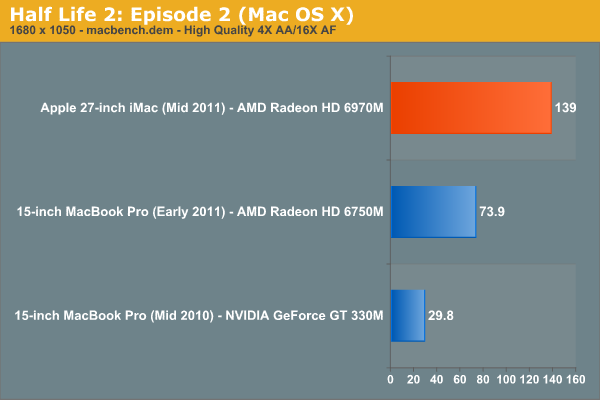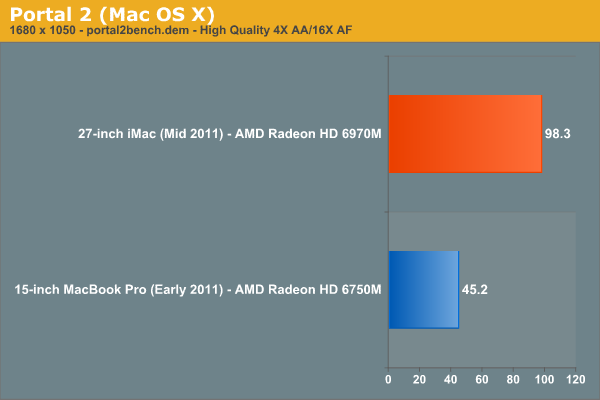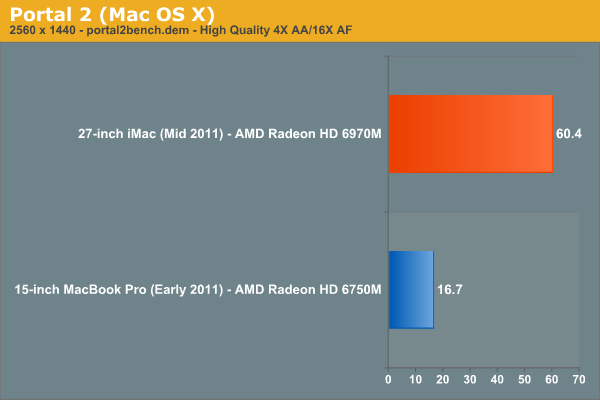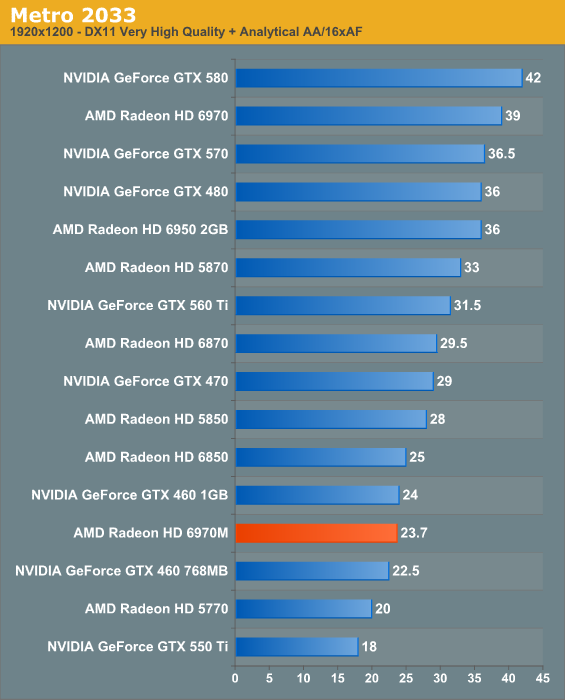The 27-inch Apple iMac Review (2011)
by Anand Lal Shimpi on May 27, 2011 2:30 AM ESTThe GPU
There are four discrete GPUs Apple offers in the new iMac and they're all from AMD, NVIDIA is completely out of the 2011 Apple lineup at this point. The entry level 21.5-inch iMac has the same Radeon HD 6750M as the upgraded 15-inch MacBook Pro. You can get a higher clocked 6770M in the upgraded 21.5 and base 27-inch models, and finally only the upgraded 27-inch iMac comes with a Radeon HD 6970M.
| GPU Options | |||||
| AMD Radeon HD 6750M | AMD Radeon HD 6770M | AMD Radeon HD 6970M | |||
| Manufacturing Process | 40nm | 40nm | 40nm | ||
| SPs | 480 | 480 | 960 | ||
| Texture Units | 24 | 24 | 48 | ||
| ROPs | 8 | 8 | 32 | ||
| Core Clock | 650MHz | 725MHz | 680MHz | ||
| Memory Bus Width | 128-bit | 128-bit | 256-bit | ||
| Memory Clock | 900MHz | 900MHz | 900MHz | ||
| Frame Buffer | 512MB GDDR5 | 512MB GDDR5 | 1024MB GDDR5 | ||
The 6970M doubles the number of shaders to 960 and doubles the memory bus width to 256-bits. The result is a GPU that has the fillrate and memory bandwidth to actually drive the 27-inch 2560 x 1440 panel...on sufficiently light games.
It's not all about compute and bandwidth, memory size matters as well. Unfortunately other than the upgraded 27-inch system, everything else only ships with a 512MB frame buffer. That's enough to drive the integrated panel but if you're running a high resolution external display as well you may notice some slowdown.
The upgraded 27-inch iMac can also be outfitted with an optional 2GB frame buffer for an extra $100. The added GB is nice but likely only useful if you have a specific application need or are running multiple displays.
| 2011 iMac GPU Comparison | ||||||
| iMac Model | $1199 21.5-inch | $1499 21.5-inch | $1699 27-inch | $1999 27-inch | ||
| Base GPU | AMD Radeon HD 6750M (512MB) | AMD Radeon HD 6770M (512MB) | AMD Radeon HD 6770M (512MB) | AMD Radeon HD 6970M (1GB) | ||
| GPU Upgrade Offered | None | None | None | AMD Radeon HD 6970M (2GB) | ||
Apple sent us the upgraded 27-inch model because 1) I asked for it and 2) Apple thinks I really care about performance. Both are indeed true. The question I wanted to answer was whether or not the Radeon HD 6970M was going to be sufficient for panel-resolution (2560 x 1440) gaming on the 27-inch iMac both now and in the future. I don't have any older iMacs handy so unfortunately we'll have to do our GPU comparisons to the MacBook Pro line.
We'll start with Half Life 2 Episode 2. A game that's definitely long in the tooth but still represents a good workload for a Source engine game on Steam. It doesn't make sense running at resolutions below 1680 x 1050 on a 27-inch panel and thankfully the 6970M does a good job here:

While even the Radeon HD 6750M can manage a respectable 73.9 fps in our test, the 6970M offers nearly double that at 139 fps.
| Half Life 2 Episode Two High Quality Settings | |||
| 2560 x 1440 - 4X AA/16X AF | |||
| 27-inch iMac (Mid 2011) - AMD Radeon HD 6970M | 112.8 fps | ||
Running at native panel resolution, the 27-inch iMac is still very playable under Half Life 2.

Moving to a more modern Source engine game: Portal 2, shows that yes you still get playable frame rates at low and high resolutions although maxed out I could only manage 60 fps on the iMac. This is far superior to the 6750M which struggles at our highest quality settings, but at 60 fps there isn't much room to grow in game complexity before the 6970M begins showing its limits.

In fact we already see those limits with Starcraft 2:
| Starcraft 2 - 2560 x 1440 - Ultra Quality Settings | ||||
| AT CPU Bench | AT GPU Bench | |||
| 27-inch iMac (Mid 2011) - AMD Radeon HD 6970M | 37 fps | 51 fps | ||
37 - 51 fps isn't the sort of buttery smoothness we've come to expect from a high end Sandy Bridge system running this game. It is very tough to drive the number of pixels we're talking about at native panel resolution. Thankfully for a game like Starcraft 2, as long as you're above 30 fps you're in good company. Drop the resolution to 1680 x 1050 and the 6970M looks a lot better:


I threw Windows 7 on the machine to put its GPU performance in perspective. Looking at Metro 2033 performance you get a good idea for where the 6970M falls compared to the performance mainstream to high end desktop GPUs we talk about regularly:


Overall performance is comparable to that of a GeForce GTX 460, which is still a great card - just not what we'd pick for driving a panel of this resolution. This is ultimately my issue with the GPU choices Apple offers with the new iMac: they are fast enough for most gaming on the Mac today, but likely aren't enough for panel resolution gaming for anything more strenuous (without dropping image quality). You can forget about most modern titles under Windows at panel resolution.










139 Comments
View All Comments
meorah - Friday, May 27, 2011 - link
"Example: My 2007 24" imac was ~£1200. Resale value for similar spec on ebay today: ~£650-700. That means it's cost me around £500-£550 over 4 years, roughly the cost of a low-end desktop with an OK screen."its cost to you was 1200. it has depreciated around 500-550 over 4 years.
If you were trying to lease an imac for 500-550 over 4 years, then it would have cost you 500-550 over 4 years, but you bought it so that's not right.
psonice - Friday, May 27, 2011 - link
What difference does it make? At some point (probably soon) I'll sell it and buy a new box. At that point it'll have cost me 500-550, for 4 years of use.KoolAidMan1 - Friday, May 27, 2011 - link
Depreciation on PC parts is much worse. I sell my old PC components on roughly the same schedule as my Macs, every 2-3 years, and with my Mac sales it is more than enough to help pay for its replacement. With my old PC parts, not so much. :)KoolAidMan1 - Friday, May 27, 2011 - link
You nailed it. You aren't "losing a good monitor" when you sell your old iMac for a new one, you're getting a better monitor with the major revisions.The 24" iMac had a great H-IPS panel in it, but the upgrade from that to the 27" IPS panels in the new iMacs is well worth the upgrade. Combine that with high resale value on Macs and its a pretty good deal, ridiculously easy upgrade too (just pack the old one in the box it came in).
DarkShift - Saturday, May 28, 2011 - link
"Basically, macs are surprisingly cheap when you factor in the resale value. You either keep them long term (and they pay for themselves then anyway), or you sell after a few years and get half your money back."That's surpsrising considering that Mac's are mostly underpowered even as new. 650£ for 2007 iMac is way too much considering how slow it must be.
I have noticed, that most people who happily buy macs really don't know anything about tech stuff. Many still think that there must be something in Apple hardware that's better than in PC's while they often share same components.
For comparison, my self build PC workstation runs circles around these iMac's and it cost me less. And that is with Intel i7 2600K @ 4.6Ghz, 3 SSD drives,16GB ddr3 ram, Blue ray and USB 3.0 ports. And absolutely no blue screens after 5 months use. ;)
Benchmarked results:
Retouch artics Photoshop (with CS5): 9,5s
Cinebench R10 Rendering single: 7690
Cinebench R10 Rendering multi: 30536
Performance is the most important thing for pro users at it tells how fast you get your job done. Other issues are mostly cosmetic as most pro software is found for both Mac and PC. You get paid for using the tools, not for using them on specific OS.
jonwd7 - Friday, May 27, 2011 - link
Unless I am mistaken, your claim that the SSD in the 2011 iMac is the same old Toshiba one they've been using is pure speculation, but you don't treat it like so. If you attempt to order a new 2011 iMac with an SSD, the shipping date gets moved back significantly. There is some possibility that this is because they are switching to a newer, possibly Samsung-branded SSD. It being Samsung is just a rumor I believe, based on what they used in the newest MacBook Airs.kevith - Friday, May 27, 2011 - link
I think it´s not a drawback, but quite the opposite, when a laptop or an all-in-one is fitted with too little RAM and/or too little HDD/SSD, since it´s the only things you can upgrade yourself.And that always cheaper than the price-premium the manufacturer will charge, certainly if the manufacturer is Apple...
So for my part I always look for laptops without SSD and with as little memory as possible.
tech6 - Friday, May 27, 2011 - link
Looks like a nice system that is held back by a design problem. Most laptops have easy access service panels for RAM and disk upgrades or replacements and the lack of this feature would rule this system out for me. That's a pity as it looks good and is reasonable value but if you have to remove the LCD and board just to get at the disk, that is just plain stupid industrial design.Johnmcl7 - Friday, May 27, 2011 - link
It's worse than stupid, it's entirely intentional as you're not supposed to repair or upgrade your iMac you're supposed to buy a new one. I cannot stand Imacs for their appalling internal design and I'm surprised a tech site like this can still praise Imacs given that laptops a fraction of the size are a two second job to get the drive out so there's absolutely no reason for the Imac to be any different.Even putting the Imac's terrible design aside, I'm not a fan of all in one PCs as I struggle to see the point unless you're really, really tight on space. You're essentially getting the disadvantages of both a laptop and a desktop but none of the advantages as the system is neither portable nor flexible/upgradeable or offering topend performance. I have a Dell U2711 which thanks to having just about every input possible can currently hook up to a few different machines and I expect it to last far beyond the current desktop PC it's mainly hooked up to. This new Imac seems even worse for use beyond the builtin computer with a very limited video input.
John
wintermute000 - Friday, May 27, 2011 - link
The main issue is that its still laptop-esque price/performance for a desktop.The lack of an apple tower or upgradable box is quite astounding. They could just keep it single socket, 8Gb RAM or under, and consumer (not pro variant) gfx cards.
2k USD can buy you a liquid cooled quad-core sandy bridge, mid-high GPU, SSD rig + a decent 24" IPS display with a spare 4 or so Tb of spinning platter storage. No contest except for OSX tax if your apps demand OSX. Back in the XP days the OS was worth the markup but no more IMO